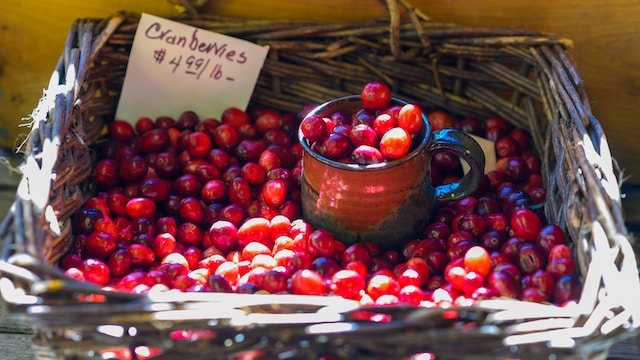How Are Cranberries Processed To Prepare Them For Shipping And Purchasing By A Consumer
The cranberries, with their vivid red hue and distinct tart taste, have for a long time been a popular ingredient at holiday tables as well as in a myriad of recipes. While the tiny fruit is a favourite for many, the trip from the cranberry bogs to your table is an intriguing process of harvesting the berries, sorting them, and packaging them for shipping, and preparation.
This article will go into the complicated procedures involved in making consumer-grade cranberries, illuminating the fascinating process these berries go through before making it to your kitchen. We will examine the processes of technology, methods, and considerations that go into making accessible cranberries and emphasize their nutritional value and the variety they offer. So, let’s start the journey of cranberries from the time of harvest to your plate.
Harvesting Cranberries

A journey for cranberries begins in the bogs, from where these vibrant red fruits are carefully harvested. The season of harvesting cranberries usually falls during the fall months, between September and November, depending on the location. The methods used to gather cranberries harvesting have developed in the past, with both modern and traditional techniques having a significant role to play.
1. Traditional Harvesting Methods
- Dry harvesting: The cranberries of the past were usually harvested dry by hand. Harvesters used wooden scoops and combs to separate the berries from the vines and put them in containers like barrels or baskets.
- Wet Harvesting: When harvesting wet, the bogs of cranberries are submerged, and the ripe cranberries are sucked towards the surface because of their air-filled pockets. Workers utilize specialized equipment like water reels and booms to gather the berries to facilitate collection.
2. Modern Harvesting Techniques
- Mechanical harvesting: Modern cranberry harvesting is typically based on automated processes. Combinations that have a rotating beater or reel are used to pull the fruit off the vines gently. They have become more efficient and lessen the need for manual work.
- Wet Harvesting Using Machine: Wet harvesting is a process that uses machines can be utilized to help collect floating cranberries. This method is popular due to its effectiveness.
Sorting And Cleaning
When cranberries are picked, The next stage in their journey to your plate is the cleaning and sorting. This step is vital to clean any traces of debris or damaged berries. It also ensures that only the best quality fruit is wrapped and distributed to customers.
1. The Need for Sorting and Cleaning
- Quality Assuring Quality: The primary goal of cleaning and sorting is to ensure high-quality cranberries. Any berries that don’t match the specifications are removed from the batch to ensure integrity.
- Health and Safety: This process also helps to remove any foreign matter or pollutants that could be introduced during the harvesting process, assuring the safety and cleanliness of the product.
2. Sorting Equipment and Techniques
- Mechanical Sorting: Convector belts and automated machinery that are equipped with sensors and cameras are commonly utilized to sort the cranberries. These machines can identify and eliminate soft, discolored, or unripe fruits, and any foreign material.
- ManualManual inspection: In some instances, manual sorting can be done to give the final quality test. Workers with training carefully examine the cranberries and then remove any remaining unwanted berries and foreign materials.
3. Cleaning Methods and Importance in Quality Control
- Cleansing the water bath: Cranberries are subject to an immersion in water where they are agitated, and other impurities such as leaves, insects, or twigs rise onto the surface and get removed.
- Dry Cleaning: Dry cleaning: vacuums or air jets are employed to eliminate undesirable materials without water. This technique is most commonly used with fresh cranberries.
- Rinse and dry: Following sorting, cleaning, and drying dried cranberries are rinsed to remove any remaining contaminants, making them in good condition for packing.
Packaging
After the cranberries have been picked and cleaned, then sorted, and sorted following the sorting and cleaning process, the next important step on their way to the consumer’s table is the packaging. Proper packaging is vital to keeping the freshness of cranberries and prolonging their shelf life, as well as shielding them from external influences that can compromise their quality.
1. Packaging Considerations for Cranberries
- Protection from external elements: Cranberries are highly susceptible to damage caused by air, moisture, or physical pressure. Packaging must protect them from the elements to preserve their quality.
- The Visibility and presentation: Clear packaging, including plastic bags, clamshell containers, or even clamshells, is commonly used to allow customers to look at the cranberries to determine freshness and color.
- Controlling the portion: Packages can be made to give different portions of different sizes, able to meet the requirements of various customers, ranging from small families to huge gatherings.
2. Types of Packaging Materials Used
- Plastic Bags: Typically used for loose cranberries, Plastic bags are economical and offer visibility. Ziplock bags that are resealable are convenient for the consumer.
- Clamshell containers: These clear plastic containers with hinges are very popular with fresh cranberries. They are obvious, provide security and convenient storage.
- Resealable Pouches: Pouches that are flexible and have ziplock seals are ideal for both frozen and fresh Cranberries. They are handy to store and are reused to preserve freshness.
- Cans of Cranberry Products: Produced cranberry items such as cranberry juice, sauce, and canned cranberry drinks typically come in glass or cans to prolong their shelf life.
3. Protection Against Spoilage and Preservation
- Refrigeration: Cranberries, particularly fresh ones, must be stored within the frig to increase their shelf time. Refrigeration can slow down the natural degrading process.
- The freezing: They can be frozen and keep their freshness for a long time. The cranberries that are frozen are typically stored in resealable containers.
- Vacuum-sealed packaging: In some instances, vacuum-sealed bags can be used to eliminate air and extend the shelf-life of cranberries, particularly when it comes to dried cranberries.
Shipping And Transportation
After cranberries have been harvested after being cleaned, sorted, and packed, the next phase of their journey is shipping them and transporting them. This step is essential to ensure that cranberries reach their destinations in the best condition possible, regardless of whether they’re heading to supermarket processing facilities, stores for processing, or other distribution centers.
1. Logistics of Shipping Cranberries
- Distribution Centers: The majority of cranberries are transported to regional distribution centers, where they are temporarily stored before being delivered to processors or retailers. These distribution centers play an essential role in providing an adequate supply of cranberries all year.
- Transport Routes: The transportation routes are carefully designed to reduce the time required to travel and ensure prompt delivery. Cranberries are typically transported by rail, road, or even water, based on the area of the bogs as well as the destination of delivery.
- Fast delivery: Cranberries have a finite shelf life, which is why it’s important to move them quickly and efficiently in order to prevent spoilage. The use of refrigeration is commonplace to keep the freshness of the berries.
2. Transportation Methods and Challenges
- Refrigerated trucks: The majority of fresh cranberries get transported by refrigerated trucks in order to ensure their freshness. Temperature control is vital to ensure that the fruit does not spoil during transport.
- The challenges: Road infrastructure, and transport regulations can create obstacles for the shipping of cranberries. Traffic, extreme temperatures, and accidents could affect the speed of delivery of berries.
- International shipping: For cranberries intended for markets outside of the United States shipping is a process that requires additional complications relating to customs regulations, regulations and a longer time for transit.
3. Cold Storage and Refrigeration During Transit
- Cold storage: Cranberries are kept in a temperature that are just below zero (32degF which is 0degC) to prolong their shelf-life. This temperature range slows down the natural degrading.
- Refrigerated Containers: Containers that are refrigerated like refrigerated trucks as well as shipping containers come with cooling systems in order to keep the temperature desired throughout the trip.
- Monitoring Systems: Monitoring systems that are sophisticated can be used to monitor temperatures and humidity levels throughout transport to ensure that Cranberries are in the best state.
Receiving And Distribution

Cranberries travel through the process of transportation. is not over when they are delivered and then transported to their destinations. The next step is to pick up the cranberries in supermarkets, distribution centers or processing facilities and later, their distribution to the consumer and further processing.
1. Handling and Receiving Cranberries at Retail Stores
- Processing of Receiving: When cranberries reach retailers, they go through the process of receiving. Store staff examine the shipments to determine their quality and verify that they meet the requirements.
- Storage Conditions: The cranberries are stored in refrigerated areas to keep their freshness. The grocery stores usually keep their displays in refrigerated open areas to make them accessible to customers.
- Retail Merchandising: The retail stores position cranberries in high-visibility locations, typically in close proximity to other fresh produce in order to get shoppers adding them into their carts.
2. Distribution Process to Reach Consumers
- Supply Chain: Cranberries are shipped from distribution centers in the region to retail stores across the country. A well-organized supply chain management system ensures that cranberries are accessible to customers all year long.
- Consumer Packaging: Cranberries, whether in bags, loose or in clamshell containers are arranged and displayed beautifully in stores so that they are easily accessible to customers.
- Shop online: With the increase of e-commerce, customers can purchase cranberries on the internet to have them sent directly to their doorstep, increasing their availability.
- Promotions and seasonality: Retailers frequently have seasonal promotions and displays to promote cranberry purchases, especially during the Christmas season, when recipes that are based on cranberry are in high demand.
3. Distribution to Processing Facilities
- Processing facilities: A large proportion of cranberries will be sent to processing facilities where they can be transformed into products such as sauce, cranberry juice as well as dried cranberries. These facilities take cranberries in large quantities.
- Processing Techniques: When they arrive in factories for processing, the cranberries will be subjected to a specific process to produce different products derived from cranberries like extraction of juice, or drying of dried cranberries.
- Quality Control: Quality control measures that are strict are employed at the processing plants to ensure that only high-quality cranberries can be used in the manufacturing process.
Conclusion
The process of growing cranberries beginning with the humble beginnings of bogs to their place as an essential ingredient on your table is an incredible process that requires multiple steps which are each crucial in bringing the vibrant red berries into your kitchen.
The cranberries are harvested carefully using both traditional and modern methods in order to ensure the finest quality fruit is chosen. They are then sorted and washing, in which meticulous inspections and automated equipment ensure that only the best fruits make it through to the next stage. Packaging plays a crucial part in maintaining freshness of the cranberries as well as making them appealing visually and prolonging their shelf-life. Once they are packaged, cranberries are then transported, typically under refrigerated conditions, until their final destination.
The journey continues when they arrive at supermarkets and then they are kept in pristine conditions and then put on display for customers to enjoy. In addition, a significant portion of the cranberries are shipped to processing facilities where they are processed into a variety of cranberry-based items.
The whole process is a testament to the effort and dedication required to provide cranberries customers in their freshest and most adaptable form. No matter if you like fresh or frozen, in an ingredient in a sauce, juice as dried or in juice, attention and care given to every stage ensures that the fruit are a delight to add to your cooking.
The next time you are able to taste the tangy cranberries of the Thanksgiving sauce, drink their refreshing juice in the summer heat, add dried cranberries to your salad, take note of the path these berries brought to your table, and be grateful for the hard work of the individuals and processes that bring them to you all year. They’re more than an aperitivo; they’re an evidence of the intricate journey that they’ve taken from the bog your table.


















